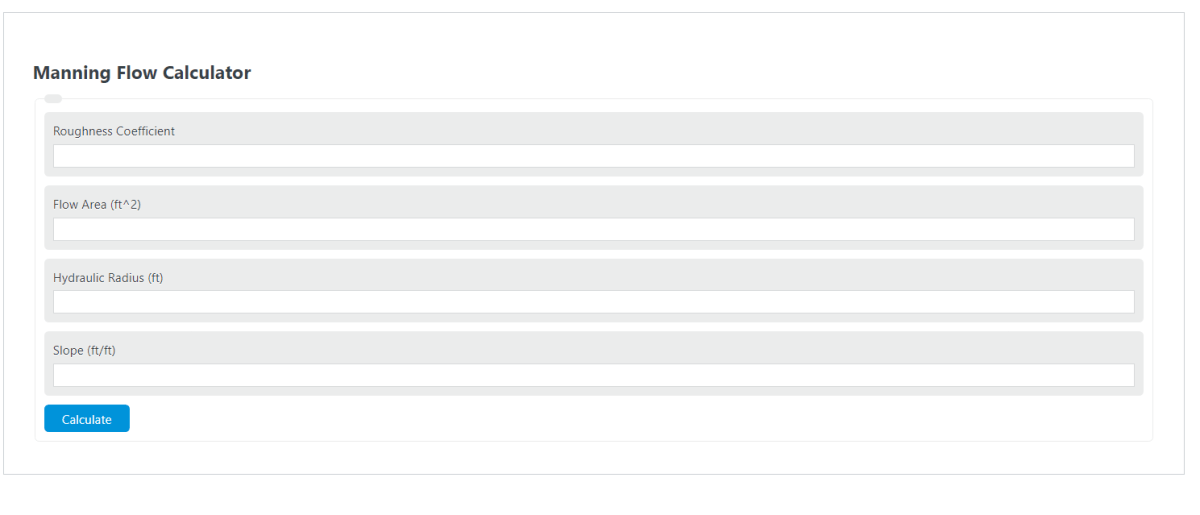Enter the roughness coefficient, flow area, hydraulic radius, and channel slope into the calculator to determine the manning flow.
- Hydraulic Motor Flow Calculator
- TFA – Total Flow Area Calculator
- Flow Rate Pressure Calculator
- Volumetric Flow Rate Calculator
- Radius of Influence Calculator
- Inlet Capacity Calculator
- Self Cleansing Velocity Calculator
Manning’s Flow Formula
The following formula is used to calculate a manning’s flow rate.
Q = (1.49/ n) * A * R^(2/3) * Sqrt (s)
- Where Q is the manning flow rate (ft^3/s)
- n is the roughness coefficient
- A is the flow area (ft^2)
- R is the hydraulic radius (ft)
- s is the channel slope (ft/ft)
What is Manning’s Flow?
Mannings flow is a metric of the volumetric flow rate of water moving through an open channel. The volumetric flow rate is calculated using Manning’s Equation which is stated above.
The equation itself was developed as an alternative to the Chezy Equation for flow through channels to try and achieve more accurate calculations.
How to calculate Manning’s Flow?
The following example outlines how to calculate open channel flow using Manning’s Equation.
First, determine the roughness coefficient. This is typically gathered through tables. For this example, the coefficient is .040.
Next, determine the total flow rate. In this example, the area is calculated to be 20 ft^2.
Next, measure the hydraulic radius. This is found to be 3 ft.
Next, determine the slope of the channel. This channel has a slope of 5ft/ft.
Finally, calculate the flow rate using the formula:
Q = (1.49/ n) * A * R^(2/3) * Sqrt (s)
Q = (1.49/ .040) * 20 * 3^(2/3) * Sqrt (5)
Q = 3456 ft^3/s
FAQ
What is the significance of the roughness coefficient in Manning’s Equation?
The roughness coefficient (n) in Manning’s Equation accounts for the internal friction within the channel that affects the flow rate. Different materials and surface textures have different coefficients, reflecting how they impede water flow. This value is crucial for accurately calculating the flow rate.
How does the hydraulic radius affect the flow rate in an open channel?
The hydraulic radius (R), which is the ratio of the flow area to the wetted perimeter, directly influences the flow rate in Manning’s Equation. A larger hydraulic radius indicates a more efficient cross-section for flow, leading to a higher flow rate. It’s a key factor in determining how easily water can move through a channel.
Why is Manning’s Equation preferred over the Chezy Equation for calculating flow in open channels?
Manning’s Equation is often preferred due to its simplicity and the minimal amount of required inputs for accurate calculations. It also accommodates a wide range of channel shapes and roughness types, making it versatile for various engineering applications. Additionally, it has been empirically validated across many scenarios, providing reliable results for water flow calculations.
